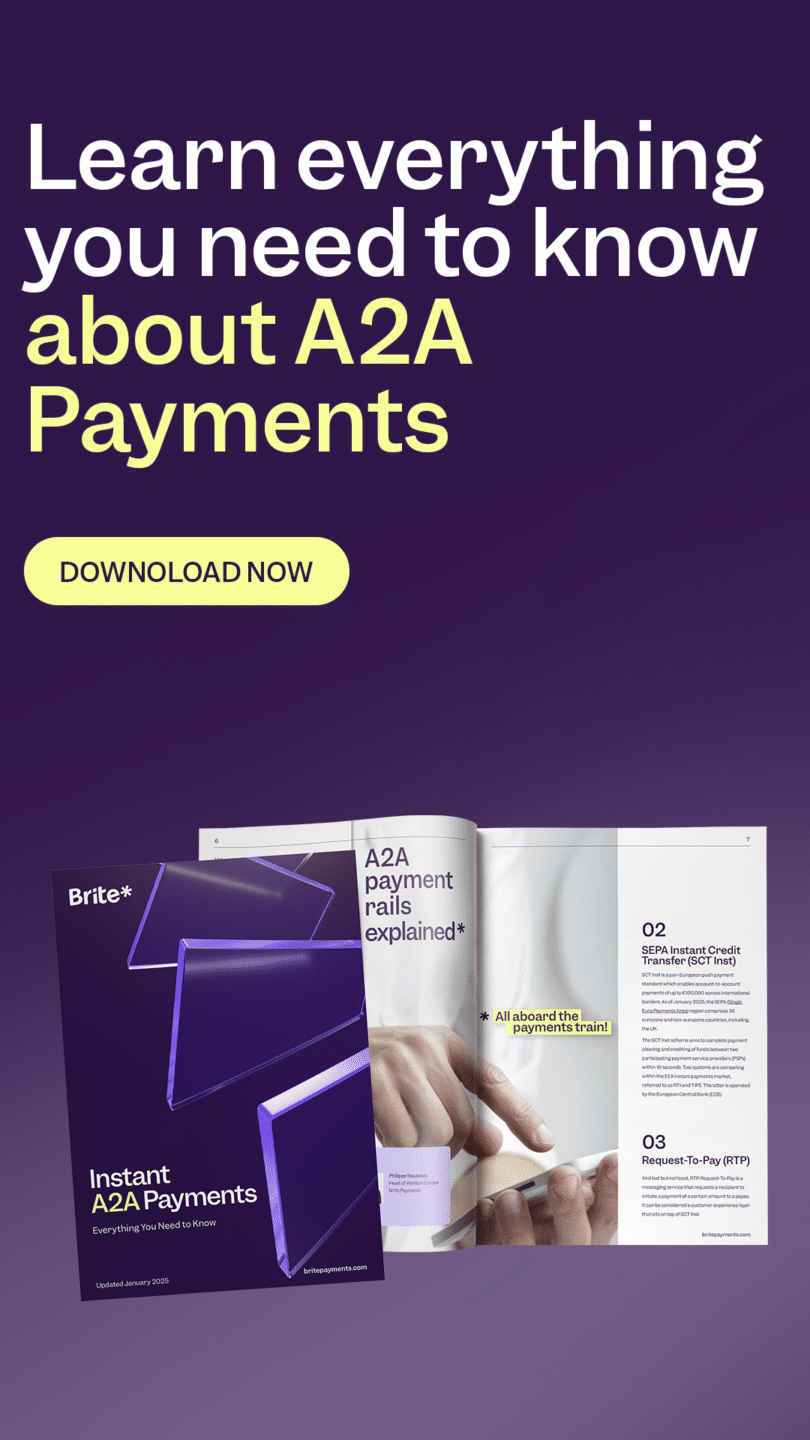
In the rapidly evolving landscape of payments, instant account-to-account (A2A) payments are emerging as a transformative force. These innovative payments bypass traditional card networks, enabling a faster, more secure, and cost-effective alternative to card payments.
We spoke with Bo Liljefors, Chief Product Officer at Brite Payments, to explore how open banking-powered A2A payments are changing how we pay and get paid. Additionally, we cover topics such as the key drivers of A2A adoption, the challenges and opportunities that lie ahead, and the transformative potential of instant A2A payments in shaping the future of commerce.
How are A2A payments changing how we pay?
Bo Liljefors, Chief Product Officer at Brite Payments: Put simply, A2A payments are changing how we pay by removing the need for your credit or debit card when paying online. That is the foremost area where we see a change and shift in behaviour.
Plus, if you “Pay by Bank” or use an A2A payment for an online purchase, you generally only have to go through one or two authentication steps. This always happens through your phone, especially in Northern Europe, where almost all banks are connected to strong customer authentication (SCA), such as Bank ID in Sweden, or have their own authentication app.
This also means you don’t have to fetch your card details if you’re on the bus and trying to make a purchase via your phone without your wallet. In the worst-case scenario, you have to punch in your whole card number with a card payment. In all cases, you must at least fill out your CVV code, and if you don’t have that top of mind, you’ll still need to get your physical card anyway.
Account-to-account is at the forefront of driving improvement and making this situation a thing of the past for consumers.
…And get paid?
Bo Liljefors: The main improvement and change is the speed of transactions. When you receive funds, a payment from a credit insurance company, or if you’ve sold stuff via a marketplace in Sweden, you’ll immediately have those funds in your account.
That’s not part of open banking per se, but it’s still an account-to-account payment that we facilitate. This has shifted the perception of payouts. Five years back, whenever you requested a payout with an operator or anywhere online, the standard was always a couple of days before you had it. Now, at least for Northern Europe, the expectation is that you should have it immediately, whether during business hours or outside of business hours.
Furthermore, open banking brings significant value to the process of getting paid by enabling verification of the account holder of the account to which the funds are paid out. This is an excellent tool for merchants to reduce the risk of fraud and abusive behaviour.
How are A2A payments and Pay by Bank connected?
Bo Liljefors: Firstly, Pay by Bank needs a formal definition. The way I interpret it is that, in most cases, it involves a setup that takes users from a website, redirects them to their bank, and then guides them through the payment process — similar to making a payment from an online bank for bills or other transactions.
So, Pay by Bank is still a form of account-to-account payment. However, it is not an account-to-account payment that uses or relies on open banking or PSD2, which refers to the new generation of A2A payment.
Pay by Bank, in this scenario, doesn’t necessarily redirect users to the bank, although this still occurs in some cases. The technology behind what users see is built around providing a smooth user experience, addressing specific user requests tailored to the needs of the merchant and third-party provider (TPP). It represents a next-generation approach.
Pay by Bank, as a concept, is still present. An example from the Netherlands, iDeal, illustrates this — and is popular and widely used, yet it’s not an open banking payment but rather a bank payment. The underlying rails are somewhat consistent, but the robustness and construction of the infrastructure vary. This is reflected in the user experience and the integration’s force in the commercial realm.
What are the barriers to adopting A2A payments for consumers and merchants? And how does Brite remove these?
Bo Liljefors: For the consumer, it’s mainly connected to user experience and a need for general awareness surrounding account-to-account payments.
Changing consumer behaviour is tricky, especially when someone doesn’t know the payment method. It’s difficult to change when you may have used the same payment method for ten years or more. Therefore, making A2A payments very user-friendly helps them become a more compelling proposition. For account-to-account payments to continue to grow and be successful, they also need to go beyond what is already out there and set a new standard.
Indeed, how we pay online is connected to how easy it is for the end user to use a service. One way of doing this is by maintaining a very high level of security around what happens – minimising fraud and maximising the reliability of the payment service.
At Brite, we do all we can to facilitate the best user journey for merchants and their customers.
Part of that process is pushing banks to add and improve their functionality because we ultimately build our service on top of the APIs that banks provide.
Yet, the geographical coverage of A2A payments can be challenging, especially when competing with well-established card schemes. Card schemes are generally global, covering regions like Germany, France, and beyond. As a merchant delving into A2A payments, it becomes imperative to ensure that an A2A provider is integrated with banks across all the markets where they may sell. Fortunately, Brite is one such A2A provider that offers this range of services.
This brings us back to the importance of education and awareness. Individuals need to become more familiar with account-to-account payments, making it essential to engage in efforts to inform and educate actively across the industry. The term remains niche, even in markets dominated by local champions like Sofort in Germany.
What are the security measures and protocols that protect A2A transactions and help build trust with customers?
Bo Liljefors: When it comes to the security of account-to-account transactions, understanding the measures and protocols in place is crucial. Security measures are pivotal in building customer trust and show that A2A transactions are as secure as traditional banking methods.
Under the framework of PSD2, precise requirements dictate how end-users should be authenticated. This involves stringent authentication standards, whether using an app, a token device, or other means. Strong Customer Authentication (SCA) is the cornerstone of this security framework, a robust standard that significantly bolsters security, making it exceptionally challenging for fraudulent activities to penetrate.
When access to account details may be compromised, having a static username and password alone is insufficient. Completing an A2A payment requires an additional layer of security through strong customer authentication. This adds a formidable barrier for individuals with malicious intent, making exploiting the system extremely challenging.
The strength of A2A security ultimately relies on the standards set by banks. And access to banks is highly sensitive, as they emphasise a high bar for security levels. Consequently, authentication methods are well-designed and powerful.
The focus on these security measures significantly reduces fraud compared to other payment methods. In practical terms, gaining access to a bank may not necessarily lead to unauthorised payments but potential unauthorised access to the bank account. Losing one’s bank ID and bank ID code triggers an immediate response, prioritising security over transactions — highlighting the proactive approach towards safeguarding customer interests.
How are A2A payments optimised for international transactions?
Bo Liljefors: The optimisation of account-to-account payments for international transactions lies in their remarkable cost efficiency compared to traditional payment methods. This optimisation is achieved by streamlining the parties facilitating and completing the payment, reducing fees and charges.
In contrast to traditional card schemes, which involve an issuing bank, acquiring bank, and various intermediaries, A2A payments typically entail a sending bank, a receiving bank, and a third party like Brite that initiates the payment. This streamlined structure makes A2A payments highly cost-effective, especially in cross-border transactions.
An illustrative example is the euro, where cross-border transfers within the Single European Payments Area (SEPA) demonstrate efficiency. SEPA has introduced requirements and fostered development, making cross-border transactions quicker, instant in most cases, and more cost-efficient. Leveraging existing infrastructure on bank rails contributes to efficiency, particularly in transactions involving the same currency.
For transactions between different currencies, such as SEK to Euro or vice versa, A2A payments offer cost-efficiency. While fees are inevitable, the SEPA initiative has played a role in reducing fees and enhancing the overall transaction experience. The infrastructure, operating on established bank rails, contributes to the efficiency of A2A payments, having been in construction for a considerable period.
Compared to card payments that often incur percentage charges, A2A transactions benefit users, especially in terms of cost. However, the exact amount may vary, and it’s essential to consider the specific currencies involved. Integrating newer countries into the SEPA operation has further contributed to fee reductions and operational improvements, ultimately enhancing user experience.
In your opinion, what is the ultimate potential for A2A payments?
Bo Liljefors: Many considerations come into play in evaluating the ultimate potential for A2A payments, particularly the type facilitated by Brite, which uses an open banking approach. Looking ahead over the next few years, the realisation of this potential hinges on various factors, including market dynamics and adoption rates.
Firstly, the potential heavily depends on the support and infrastructure banks provide. Although progress has been made, especially in some regions, there’s recognition that certain developments from banks are still essential, particularly in Southern Europe.
Secondly, Brite acknowledges its responsibility to build compelling products that appeal to consumers and merchants. The emphasis on creating a seamless, secure, and impressive payment experience for consumers is pivotal. Simultaneously, merchants should find value in lower costs and swift access to funds. The following two to three years are deemed crucial in achieving these objectives.
While traditional payment methods, such as cards, continue to evolve, A2A payments are perceived as advancing more rapidly. The potential is evident, but there’s a parallel need to foster broader adoption actively. For example, certain industries may find it more straightforward to embrace A2A payments.
Yet, the potential for A2A payments shines in specific verticals, particularly those with higher transaction amounts – adding an extra layer of security. Digital goods, in particular, emerge as a promising use case. Beyond traditional commerce, potential applications are seen in financial services, fund transfers, and even in-game solutions. Indeed, the security and safety of A2A payments, as well as cost efficiency, can bring excellent value to verticals with high ticket sizes, such as online auction houses.

